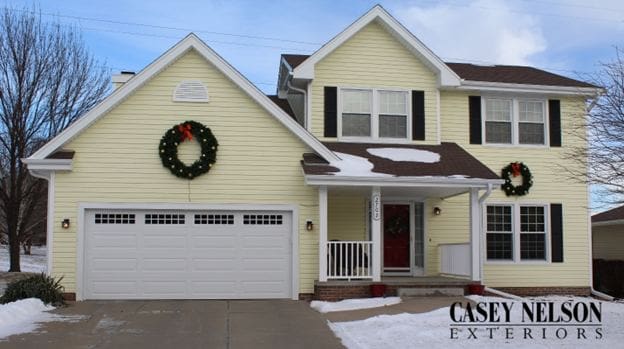Winter weather is just around the corner. Are you and your home ready for colder temperatures and Nebraska snow storms? Below you will find a list of items to consider doing before the freezing temperatures, heavy snowfall, and icy conditions are upon us. Completing these projects in late fall or early winter can prevent expensive repairs and reduce your energy bills.
Heating and Insulation Checklist:
_____ Inspect and service your furnace or HVAC system. Have a professional inspect your heating system to ensure it is running efficiently and to catch any issues before they become an emergency.
_____ Replace air filters. For both your furnace and any humidifiers, replace or clean filters to maintain good airflow and indoor air quality.
_____ Check insulation levels. Ensure your attic, basement, and crawl spaces have adequate insulation to prevent heat loss. A well-insulated house can significantly lower your heating costs.
_____ Seal air leaks. Check windows, doors, and the foundation for any gaps or cracks. Use caulk, weatherstripping, or foam sealant to keep cold air out and warm air in.
_____ Reverse ceiling fans. Change the rotation of your ceiling fans to a clockwise direction to push warm air trapped near the ceiling back down into the room.
_____ Maintain your fireplace and chimney. If you have a fireplace, get a professional chimney sweep to inspect and clean it to remove creosote buildup, which is a fire hazard.
Plumbing and Water Systems Checklist:
_____ Drain outdoor water sources. Disconnect and drain all garden hoses before storing them. Shut off the water supply to your outdoor faucets from the valve inside your home and leave the exterior faucet open to allow any remaining water to drain.
_____ Blow out sprinkler lines. Prevent underground pipes from freezing and bursting by draining and blowing out your in-ground sprinkler or irrigation system.
_____ Insulate exposed pipes. Pay special attention to pipes in unheated areas like your basement, crawl space, and garage by wrapping them in foam insulation or heat tape.
_____ Allow faucets to drip. During extreme cold snaps (below 20°F in Nebraska), letting a faucet drip slowly can prevent pipes from freezing by keeping water moving.
_____ Open cabinet doors under sinks. This allows warmer air from the room to circulate and reach pipes concealed within the cabinets.
_____ Locate your water shut-off valve. Know where to find your main water shut-off valve and how to use it in case of a burst pipe.
Exterior and Yard Care Checklist:
_____ Clean gutters and downspouts. Remove all leaves, twigs, and other debris. Clogged gutters can lead to ice dams, which can cause severe roof and water damage.
_____ Trim trees. Cut back any overgrown or dead tree branches that hang over your house or power lines. Heavy ice and snow can cause branches to break and fall.
_____ Store outdoor furniture and equipment. Protect items like patio furniture, barbecues, lawn mowers, and gardening tools from the elements by cleaning them and storing them in a garage or shed.
_____ Prepare paved surfaces. Seal cracks in your driveway and walkways to prevent damage from freeze-thaw cycles. Stock up on ice melt or sand to ensure clear, safe paths.
_____ Protect landscaping. Place a thick layer of mulch around delicate plants and shrubs to insulate their roots. Avoid walking on your lawn when the grass is frozen to prevent damage.
_____ Check your roof. Before the snow falls, inspect your roof for any missing or damaged shingles that could lead to leaks.
Safety and Emergency Preparedness Checklist:
_____ Check smoke and carbon monoxide detectors. Test all detectors and replace batteries to ensure they are working properly. This is critical as you’ll be running heating appliances with sealed windows.
_____ Assemble an emergency kit. Put together a kit with essentials like flashlights, batteries, blankets, bottled water, and non-perishable food in case of a power outage.
_____ Test winter equipment. Take out and inspect your snow blower and shovels so you aren’t scrambling for working equipment after the first big snowfall.
_____ Beware of carbon monoxide. Never use a gas range or oven to heat your home, and ensure furnace and water heater vents are free of obstructions. Be sure your home is equipped with working carbon monoxide detectors.
NOTE: Carbon monoxide (CO) detectors should be placed in the following locations:
On Every Floor:
- Install one detector on each floor of your home, including the basement.
Near Sleeping Areas:
- Place a detector in each bedroom or outside each sleeping area.
Near Fuel-Burning Appliances:
- Install a detector within 15 feet of any fuel-burning appliances, such as furnaces, fireplaces, or gas stoves.
In Attached Garages:
- If your home has an attached garage, place a detector in the garage.
Specific Placement:
- Mount the detector on a wall or ceiling, at least 5 feet above the floor.
- Avoid placing it near windows, doors, or vents.
- Keep it out of reach of children and pets.
Additional Considerations:
- Use interconnected detectors so that if one goes off, they all do.
- Test your detectors monthly and replace the batteries as needed.
- Follow the manufacturer’s instructions for proper installation and maintenance.




